Building Everywhere, Faster: Cross-Platform Tools in 2025
Developing for multiple operating systems can be time-consuming and expensive. Cross-platform development tools solve this by enabling creation of apps from a single codebase. This listicle provides ten leading cross platform development tools to consider in 2025. Quickly compare features, benefits, and drawbacks of Flutter, React Native, Xamarin, Ionic, Electron, Unity, PhoneGap/Apache Cordova, NativeScript, Qt, and Kotlin Multiplatform to find the right tool for your project.
1. Flutter
Flutter, developed by Google, stands as a prominent cross platform development tool empowering developers to craft natively compiled applications for mobile, web, and desktop from a single codebase. Leveraging the Dart programming language, Flutter offers a rich repository of pre-designed widgets adhering to Material Design and Cupertino (iOS) guidelines. This facilitates the creation of visually appealing and responsive applications across diverse platforms, making it a powerful solution for businesses and developers seeking efficient cross-platform development.

Flutter's inclusion in this list of top cross platform development tools is well-deserved due to its impressive performance, consistent UI, and rapidly expanding ecosystem. Its "hot reload" feature drastically speeds up development by instantly reflecting code changes, while the single codebase approach significantly reduces development time and costs compared to native development for individual platforms. For developers targeting iOS, Android, web, and desktop simultaneously, Flutter offers a compelling value proposition. It’s particularly useful for startups aiming to reach a broad audience with a limited budget or established companies wanting to streamline their development process. Practical applications range from e-commerce apps and social networking platforms to interactive business tools and games.
Key Features and Benefits:
- Hot Reload: See code changes reflected in the app instantly without restarting or recompiling, accelerating the development cycle.
- Single Codebase: Develop for iOS, Android, web, and desktop from a single codebase, saving time and resources.
- Rich Widget Library: Leverage a vast collection of customizable widgets to build visually consistent and platform-adaptive UIs.
- Native Performance: Experience near-native performance thanks to Dart's ahead-of-time (AOT) compilation to ARM code.
- Comprehensive Tooling: Benefit from robust debugging tools and integrated development environments (IDEs) like Android Studio and Visual Studio Code.
Pros:
- Excellent Performance: Flutter apps boast near-native speed and smooth animations.
- Consistent UI: Maintain a uniform look and feel across different platforms with ease.
- Growing Community: Tap into a vibrant and supportive community for assistance and resources.
- Strong Google Backing: Benefit from the stability and continuous improvement provided by Google's support.
Cons:
- Larger App Size: Flutter apps can be larger than native apps due to the inclusion of the Flutter engine.
- Dart Learning Curve: Developers unfamiliar with Dart may face an initial learning curve.
- Platform-Specific Features: Accessing certain platform-specific features might require native code integration through platform channels.
- Third-Party Libraries: While the ecosystem is maturing rapidly, some specialized libraries might still be less developed compared to native platforms.
Technical Requirements: A moderately powerful computer is recommended for smooth development. Specific requirements vary slightly depending on the target platform but generally include sufficient RAM, disk space, and a compatible operating system.
Pricing: Flutter is completely open-source and free to use.
Comparison with Similar Tools: Compared to other cross-platform solutions like React Native and Xamarin, Flutter often delivers superior performance due to its direct compilation to native code. While React Native uses a bridge to interact with native components, Flutter renders its UI directly, leading to smoother performance.
Implementation/Setup Tips: Getting started with Flutter is straightforward. Download the Flutter SDK from the official website, follow the platform-specific setup instructions, and install a compatible IDE. Numerous online resources, tutorials, and documentation are available to guide developers through the setup process and initial development.
Website: https://flutter.dev
2. React Native
React Native is a powerful cross platform development tool created by Facebook, enabling developers to build native-like mobile applications using JavaScript and React. Unlike frameworks that rely on webviews, React Native utilizes native components, resulting in a smoother, more responsive user experience that closely resembles a truly native app. This framework bridges the gap between JavaScript and native platform APIs, granting access to device features like the camera, GPS, and accelerometer. This makes it a compelling choice for developers seeking a balance between cross-platform compatibility and native performance.
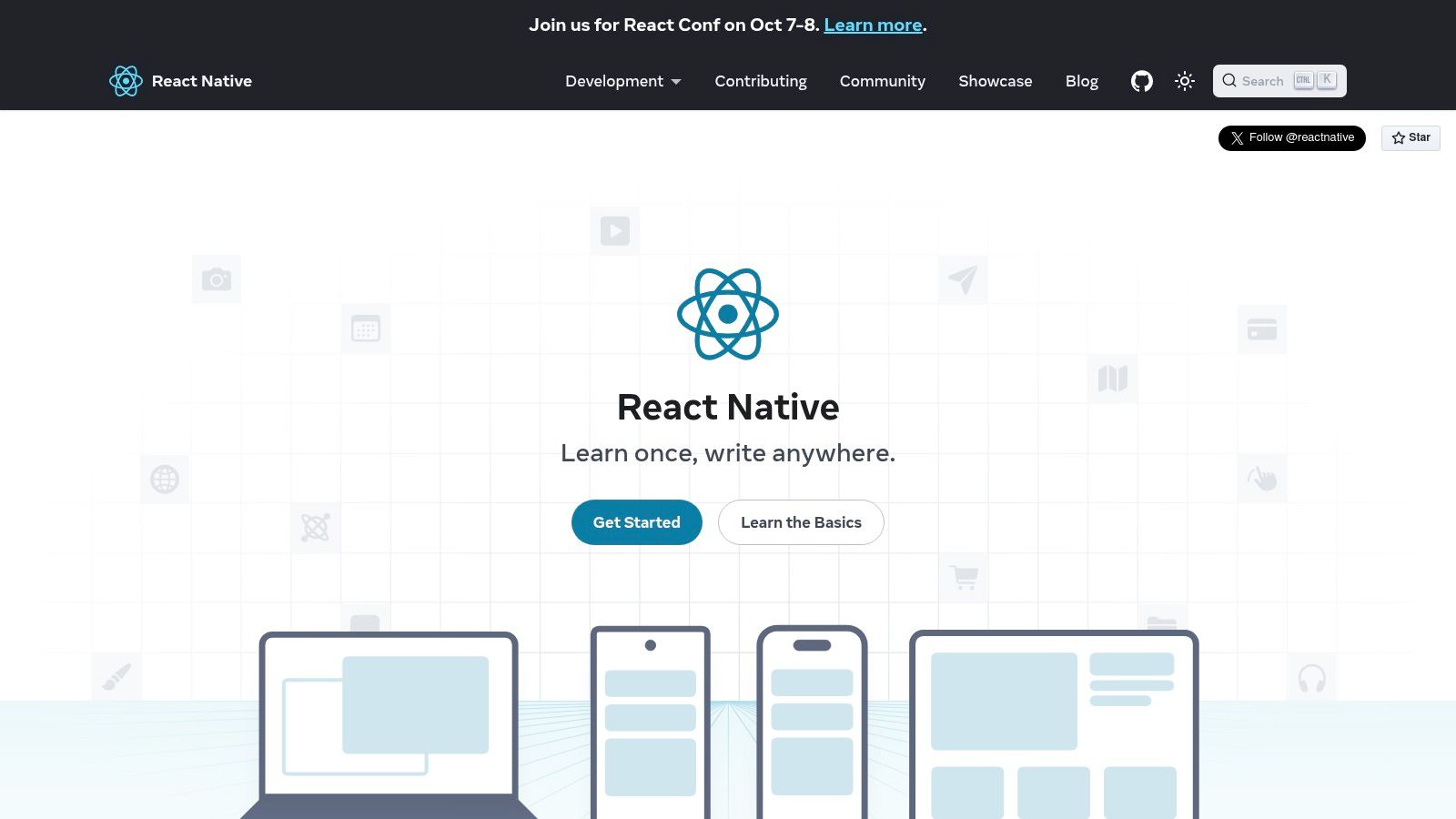
One of React Native's most significant advantages is its component-based architecture. This allows developers to create reusable UI elements, significantly streamlining the development process and promoting code maintainability. Learn more about React Native for insights on structuring your code effectively. Leveraging the extensive npm ecosystem, developers can readily integrate a wealth of third-party libraries and tools, further accelerating development. Features such as live reloading enhance the development workflow, allowing developers to see changes reflected instantly in the app. This rapid feedback loop accelerates the debugging and iteration process.
For developers already proficient in JavaScript and React, the learning curve for React Native is relatively gentle. This accessibility, combined with a large and active community, makes it a popular choice for cross platform development. The ability to access native APIs directly when needed ensures that performance-critical or platform-specific features can be implemented seamlessly. While primarily JavaScript-based, React Native does allow for the integration of native code modules when necessary, offering a degree of flexibility not found in purely web-based cross-platform solutions.
However, React Native is not without its drawbacks. Performance can be a concern for applications with complex animations or heavy computational tasks. While generally stable, frequent updates to the framework can occasionally introduce breaking changes, requiring developers to adapt their codebases. Navigation implementation can also be more complex compared to some other cross-platform tools. Lastly, despite the ability to bridge to native APIs, some highly specialized features might still necessitate writing platform-specific native code.
Key Features:
- Live Reloading
- Component-Based Architecture
- Native Module Support
- Extensive npm Ecosystem
- Strong Integration with Native Components
Pros:
- JavaScript-based, accessible to web developers
- Large and active community support
- Extensive third-party libraries and tools
- Direct access to native APIs
Cons:
- Performance challenges with complex animations
- Potential for breaking changes with updates
- Navigation can be complex
- May require native code for some features
Website: https://reactnative.dev
React Native’s position as a leading cross platform development tool is solidified by its blend of JavaScript accessibility, native performance, and a vibrant ecosystem. While not a perfect solution for every project, its strengths make it an excellent choice for a wide range of mobile application development needs, particularly when a native look and feel is desired.
3. Xamarin
Xamarin, a Microsoft-owned cross-platform development tool, empowers developers to build native mobile applications for Android, iOS, and Windows using C# and the .NET framework. This powerful tool utilizes a single, shared codebase, allowing developers to write once and deploy across multiple platforms, maximizing code reusability and reducing development time and costs. Xamarin applications don't compromise on performance or native feel; they leverage platform-specific APIs, providing access to the full spectrum of device functionalities. Furthermore, the UI layer is tailored for each operating system, ensuring a truly native user experience. This makes Xamarin a strong contender amongst cross platform development tools.
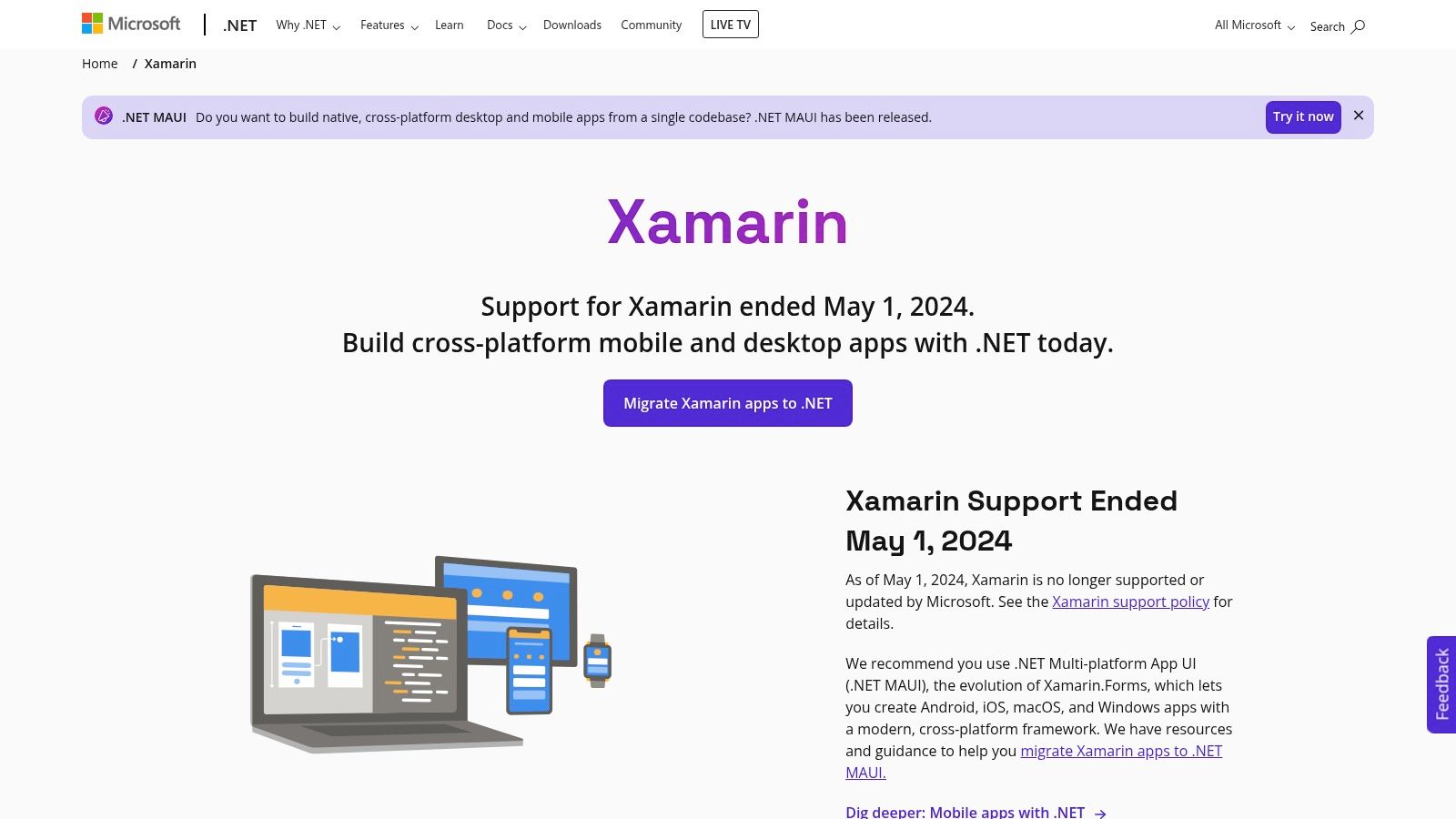
Xamarin's key features include native UI, performance, and access to platform-specific APIs, with potential code sharing across platforms reaching up to 90%. Its reliance on the widely adopted C# language and .NET framework provides a familiar environment for many developers. Furthermore, seamless integration with Visual Studio streamlines the development process, offering a robust and feature-rich IDE. Xamarin.Forms, a dedicated component, further enhances code sharing by enabling the creation of a shared UI codebase for even greater efficiency across platforms. Thinking about code quality? Learn more about Xamarin and its impact on maintainability.
One of Xamarin's standout benefits is its tight integration with the Microsoft ecosystem, making it an ideal choice for developers already working within that environment. This integration ensures access to a wealth of resources, libraries, and support. The ability to achieve near-native performance and appearance is a crucial advantage, providing a high-quality user experience comparable to natively developed applications. Using a single language (C#) across all platforms simplifies development and reduces the need for specialized expertise in multiple languages. Moreover, Xamarin developers enjoy access to the comprehensive suite of .NET libraries, offering a rich set of tools and functionalities.
While Xamarin offers compelling advantages, it's important to acknowledge some potential drawbacks. One notable consideration is the larger app size compared to native applications. Also, updates to Xamarin may occasionally lag behind native platform releases. While Xamarin provides access to most platform-specific libraries, there might be limited access to certain niche libraries. Lastly, for developers unfamiliar with the .NET framework, there can be a steeper learning curve.
Xamarin is available as part of Visual Studio. For detailed pricing and licensing information for Visual Studio, refer to the Microsoft website. Setting up Xamarin involves installing the necessary components within Visual Studio and configuring the environment for the target platforms (Android, iOS, Windows). Detailed documentation and tutorials are available on the official Xamarin website (https://dotnet.microsoft.com/apps/xamarin).
Compared to other cross-platform tools like React Native and Flutter, Xamarin distinguishes itself with its focus on native performance and deep integration with the .NET ecosystem. While React Native and Flutter utilize JavaScript and Dart respectively, Xamarin leverages C#, offering a distinct advantage for developers proficient in this language and the .NET environment. Ultimately, the choice between these tools depends on project requirements, developer expertise, and desired performance characteristics.
4. Ionic
Ionic is a powerful open-source framework that empowers developers to build high-quality cross-platform mobile, desktop, and Progressive Web Apps (PWAs) using familiar web technologies like HTML, CSS, and JavaScript. It's a particularly attractive option for those looking to leverage their existing web development skills to create truly native-feeling experiences across multiple platforms. Ionic primarily focuses on the frontend UI/UX, offering a rich library of pre-built components, and integrates seamlessly with popular JavaScript frameworks such as Angular, React, and Vue. For access to native device functionalities like camera, GPS, and file storage, Ionic utilizes Capacitor (its own native runtime) or Cordova. This allows developers to write once and deploy everywhere, significantly streamlining the development process for cross platform development tools.

One of Ionic's key strengths is its comprehensive collection of pre-designed UI components. These components are not merely web elements styled to look native; they are adaptive components that adhere to the design guidelines of each platform (iOS, Android, and web). This allows for a consistent and platform-appropriate user experience without requiring developers to manually tailor the UI for each operating system. The live reload feature during development significantly speeds up the process by instantly reflecting changes in the app, fostering rapid prototyping and iteration.
Practical Applications and Use Cases:
- Prototyping: Ionic's ease of use and rapid development capabilities make it an excellent choice for quickly building and testing mobile app prototypes.
- Cross-Platform Apps: Develop apps for iOS, Android, and the web from a single codebase, saving time and resources. Ideal for startups and businesses looking to reach a wide audience.
- Progressive Web Apps (PWAs): Build PWAs that combine the reach of the web with the engagement of native apps, leveraging Ionic's web-centric approach.
- Enterprise Mobile Apps: Develop internal enterprise apps with a consistent user experience across various devices, simplifying deployment and maintenance.
Pricing and Technical Requirements:
Ionic is open-source and free to use. However, they offer the Ionic Portals product for deploying multiple micro frontends to a single native app. Technical requirements primarily involve Node.js and npm (Node Package Manager). Familiarity with Angular, React, or Vue is beneficial but not strictly required as Ionic can be used with plain JavaScript as well.
Comparison with Similar Tools:
Compared to other cross-platform frameworks like React Native and Flutter, Ionic offers a lower barrier to entry for web developers. While React Native and Flutter offer potentially better performance for highly complex applications, Ionic excels in ease of development and speed of prototyping, especially for projects heavily relying on web technologies.
Implementation/Setup Tips:
- Install the Ionic CLI:
npm install -g @ionic/cli - Create a new project:
ionic start myApp tabs(choose a starter template) - Choose your framework (Angular, React, Vue, or JavaScript)
- Run the app:
ionic serve(for development) orionic capacitor run(for native builds)
Pros:
- Low barrier to entry for web developers
- Extensive, platform-adaptive UI components
- Single codebase for web, iOS, and Android
- Strong community and comprehensive documentation
Cons:
- Performance can be a concern for complex applications relying heavily on native functionality
- Reliance on WebView can impact performance compared to fully native apps
- Some native features require plugins, adding potential complexity
- Platform-specific adjustments might be needed for optimal UI/UX
Website: https://ionicframework.com
Ionic deserves its place in this list of cross platform development tools due to its focus on leveraging web technologies to efficiently build high-quality cross-platform applications. It's a compelling solution for developers looking to target multiple platforms without the overhead of learning multiple native languages and frameworks. Its extensive component library, vibrant community, and easy integration with popular JavaScript frameworks make it a strong contender in the cross-platform development landscape.
5. Electron
Electron empowers developers to create cross-platform desktop applications using familiar web technologies: HTML, CSS, and JavaScript. This open-source framework, developed by GitHub, essentially combines the Chromium rendering engine and the Node.js runtime environment, allowing you to package web applications as native installable applications for Windows, macOS, and Linux. This approach significantly streamlines cross-platform development, eliminating the need to learn separate languages and frameworks for each operating system. Electron's appeal stems from enabling developers to leverage their existing web development skills to build desktop experiences. For developers seeking efficient cross platform development tools, Electron stands out as a robust and versatile solution.
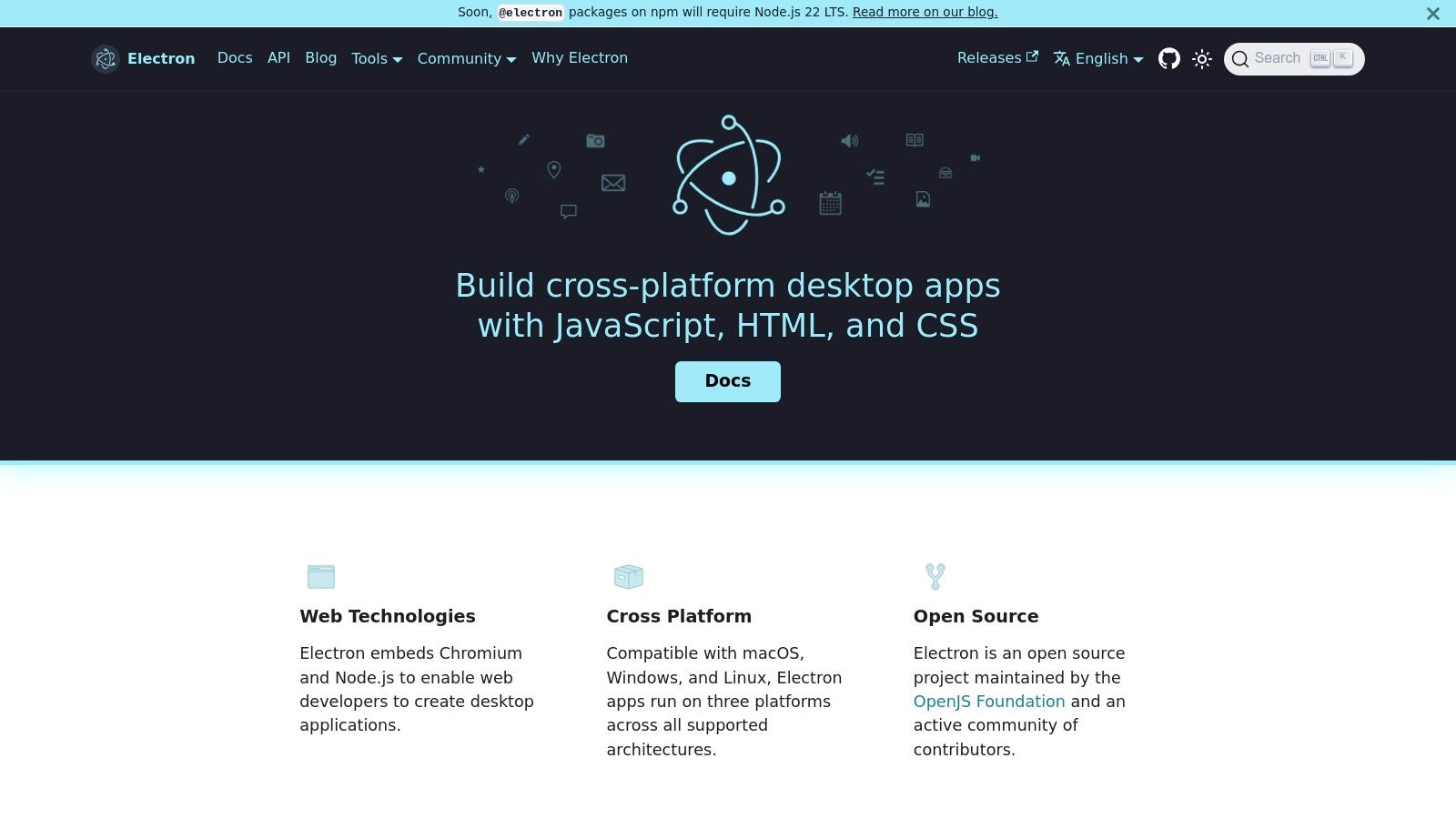
Electron's key features make it a compelling choice for a wide range of applications. It provides access to Node.js APIs directly within your application, enabling interaction with the file system, operating system functionalities, and a vast library of npm modules. This blend of front-end and back-end capabilities within a single environment simplifies complex application logic. Features like auto-updates, native menus, and integration with existing web applications further enhance developer productivity. Moreover, Electron offers robust debugging and profiling tools to aid in troubleshooting and performance optimization. You can even consider structuring your Electron projects thoughtfully, perhaps drawing inspiration from resources like Learn more about Electron for efficient project management.
Electron truly shines when rapid prototyping and cross-platform deployment are paramount. Consider scenarios like building data visualization dashboards for data scientists, creating custom tools for DevOps engineers, or developing interactive educational software. The ability to leverage existing web technologies makes Electron particularly attractive for teams already proficient in JavaScript and related frameworks. Furthermore, the rich ecosystem of plugins and tools significantly expands Electron's capabilities, catering to a diverse range of project needs.
While Electron offers numerous advantages, it's essential to be aware of its limitations. The inclusion of the Chromium engine results in larger application sizes compared to native applications. This can impact download times and disk space usage. Furthermore, Electron applications tend to consume more memory than their native counterparts, potentially affecting performance on resource-constrained devices. For computationally intensive tasks, particularly those common in AI/ML workflows, performance bottlenecks can arise. Finally, the extensive system access granted to Electron applications has raised some security concerns, necessitating careful consideration of security best practices during development.
Electron is free to use, being an open-source project.
Despite its drawbacks, Electron's strengths make it a valuable tool for cross-platform development. Its accessibility to web developers, rapid development capabilities, and vibrant ecosystem outweigh the potential drawbacks for many projects, firmly securing its place among leading cross platform development tools. You can explore Electron further and delve into its documentation and resources at https://www.electronjs.org.
6. Unity
Unity stands out as a premier cross-platform development tool, particularly renowned for its prowess in game development. While its roots lie in creating interactive 2D and 3D games, its capabilities extend far beyond, encompassing simulations, interactive experiences, and applications across a wide range of platforms. From mobile devices and desktops to web browsers, consoles, augmented reality (AR), and virtual reality (VR), Unity's reach makes it a versatile choice for developers seeking a single solution for multi-platform deployment. This adaptability is a key reason for its inclusion in this list of top cross-platform development tools. Leveraging C# as its primary scripting language, combined with a powerful visual editor, Unity empowers developers to bring their creative visions to life with remarkable efficiency.

Unity's feature set caters to both novice and experienced developers. Its visual development environment, featuring real-time editing, provides immediate feedback, streamlining the iterative development process. A comprehensive physics engine allows for realistic interactions within virtual worlds, while advanced graphics capabilities and rendering options empower developers to create visually stunning experiences. Further enhancing its appeal is the Unity Asset Store, a vast repository of ready-to-use components, scripts, and assets, enabling developers to accelerate their projects by leveraging pre-built functionalities.
For software developers, AI/ML practitioners, and technical project managers seeking to build interactive applications or simulations, Unity presents a compelling solution. For example, data scientists can use Unity to visualize complex datasets in engaging and interactive 3D environments, while DevOps engineers can leverage it to create training simulations for complex systems. The ability to deploy across multiple platforms minimizes development time and resources, making it an attractive option for projects with broad target audiences.
Features:
- Visual development environment with real-time editing
- Support for multiple platforms (mobile, desktop, web, consoles, AR, VR)
- Comprehensive physics engine
- Advanced graphics capabilities and rendering options
- Asset store with thousands of ready-to-use components
Pros:
- Powerful visual development environment simplifies complex tasks.
- Extensive documentation and a large, active community provide ample support.
- Flexible deployment to virtually any platform streamlines distribution.
- Regular updates introduce new features and improvements, ensuring the platform remains cutting-edge.
Cons:
- Can present a steep learning curve for absolute beginners.
- Development can be resource-intensive, requiring powerful hardware.
- The free tier includes splash screen branding, which may not be suitable for all projects.
- Performance optimization can be challenging, requiring careful planning and execution.
Pricing: Unity offers a tiered pricing structure ranging from a free personal edition to paid professional and enterprise plans. Details are available on the Unity website.
Technical Requirements: System requirements vary based on the target platform and project complexity. Detailed specifications are available on the Unity website.
Implementation/Setup Tips:
- Download the appropriate version of Unity Hub for your operating system.
- Create a Unity ID to access resources and manage projects.
- Start with a small project to familiarize yourself with the interface and workflow.
- Utilize the vast online resources, tutorials, and community forums available.
Comparison with Similar Tools: While Unreal Engine is a comparable cross-platform game engine, Unity often shines due to its ease of use, especially for beginners. Furthermore, Unity's extensive platform support and thriving community make it a strong contender for cross-platform development.
Website: https://unity.com
7. PhoneGap/Apache Cordova
Apache Cordova (formerly PhoneGap) earns its spot on this list of cross platform development tools due to its accessible approach to mobile development. It empowers developers to build cross-platform mobile applications using familiar web technologies like HTML5, CSS3, and JavaScript. This means web developers can leverage their existing skillset to create mobile apps without needing to learn platform-specific languages like Swift or Kotlin. Cordova achieves this by wrapping the web application in a native container, essentially embedding a WebView that renders the UI. This container can then access native device features like the camera, GPS, and accelerometer through a JavaScript API, bridging the gap between web and native functionalities.
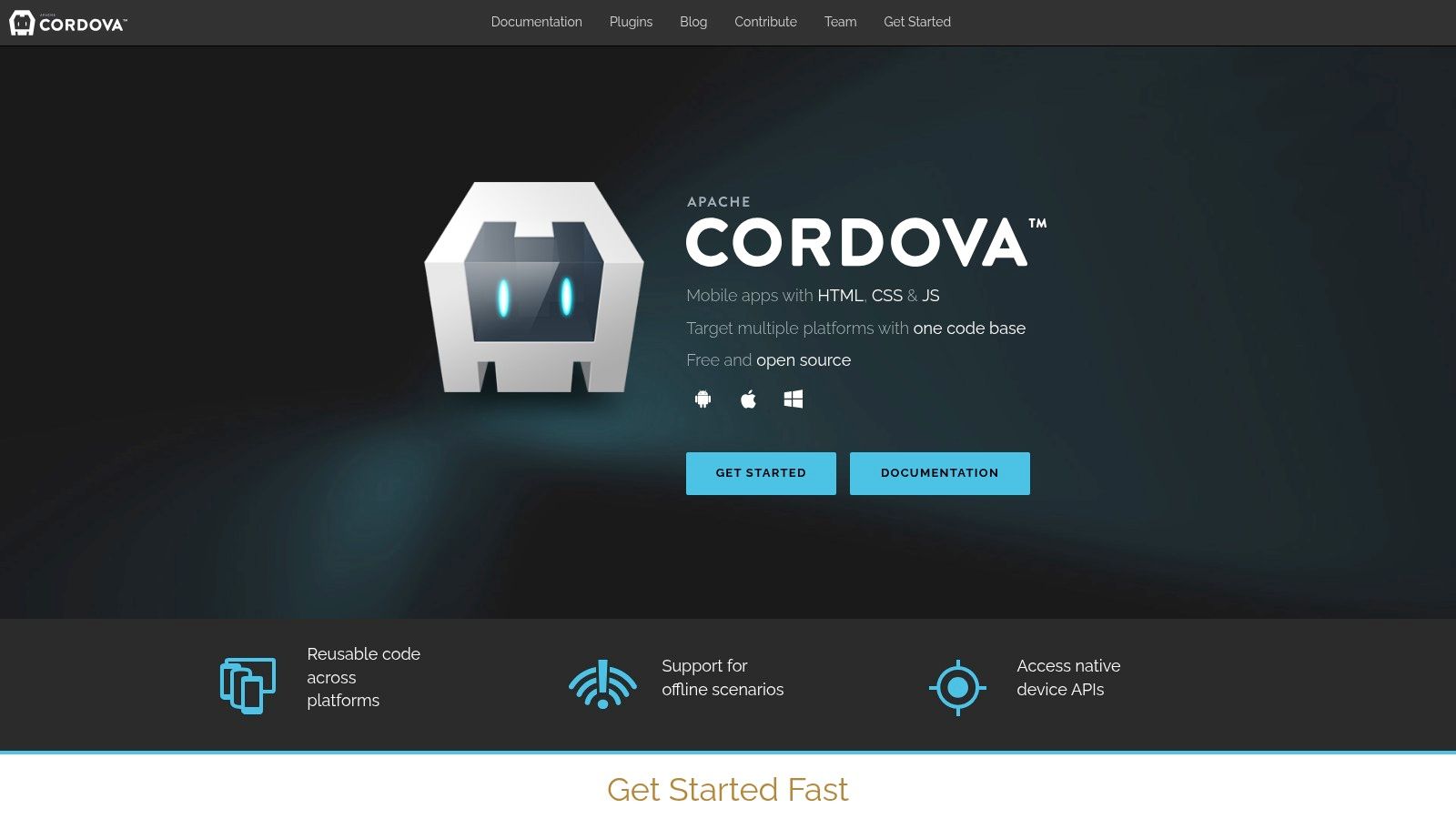
Cordova's strength lies in its robust plugin ecosystem and large community support. These plugins provide the necessary interfaces to interact with various device hardware and software features. Need to integrate push notifications? There's a plugin for that. Want to access the device's file system? There's a plugin for that too. This extensive plugin library simplifies complex integrations, significantly speeding up development time. Furthermore, the large community ensures readily available resources, tutorials, and support for troubleshooting.
One of the key benefits of choosing Cordova for cross platform development is the ability to maintain a single codebase for multiple platforms. Write the code once and deploy it across iOS, Android, and other supported platforms. This drastically reduces development time and cost compared to developing native apps for each platform individually. This single codebase approach is particularly attractive for projects with limited resources or tight deadlines.
For developers already comfortable with JavaScript frameworks like React, Angular, or Vue.js, Cordova offers seamless integration. You can use your preferred framework to build the application's UI and logic, further streamlining the development process. This flexibility makes Cordova a versatile choice for various project types, from simple utility apps to more complex applications.
While Cordova offers numerous advantages, it's essential to be aware of its limitations. Performance can be a concern, especially for graphics-intensive applications. Because the UI renders within a WebView, it may not be as smooth and responsive as native apps. Additionally, achieving consistent UI/UX across all platforms can sometimes be challenging due to the variations in WebView implementations across operating systems. Debugging can also be more complex due to the interplay between web and native environments.
Features:
- Access to native device features via plugins
- Single codebase for multiple platforms
- Ability to use any JavaScript framework
- WebView-based rendering for UI
- Extensive plugin ecosystem
Pros:
- Familiar web technologies make development accessible
- Large community and plugin ecosystem
- Low learning curve for web developers
- Rapid prototyping and development
Cons:
- Performance limitations compared to native apps
- WebView rendering can cause inconsistent UI
- Less suited for graphics-intensive applications
- Debugging across platforms can be challenging
Implementation/Setup Tips:
Setting up Cordova is straightforward. You'll need Node.js and npm (Node Package Manager) installed. Then, install the Cordova CLI globally using npm install -g cordova. From there, you can create new projects, add platforms (like iOS or Android), and install plugins using the CLI. Detailed documentation and tutorials are available on the Apache Cordova website.
Website: https://cordova.apache.org
In comparison to other cross-platform tools like React Native or Flutter, Cordova prioritizes accessibility and ease of use for web developers. While React Native and Flutter may offer better performance, they involve learning new frameworks and concepts. Cordova, on the other hand, allows web developers to dive straight into mobile development using their existing skills, making it an ideal choice for projects where speed and familiarity with web technologies are paramount. Choosing the right tool depends on the specific project requirements, budget, and team expertise.
8. NativeScript
NativeScript empowers developers to craft truly native mobile applications for iOS and Android using familiar web technologies like JavaScript, TypeScript, Angular, and Vue.js. This open-source framework distinguishes itself from WebView-based cross-platform tools by leveraging the native platform's rendering engine. This means your app's UI components are rendered natively, leading to performance comparable to apps built with platform-specific languages like Swift or Kotlin, and a genuine native look and feel. NativeScript further streamlines development by providing direct access to native APIs, eliminating the need for cumbersome plugins or wrappers for core device functionalities. This is a significant advantage for developers targeting specific platform features. Its inclusion in this list of top cross-platform development tools is warranted by its ability to deliver high-performance native experiences using web development skills.
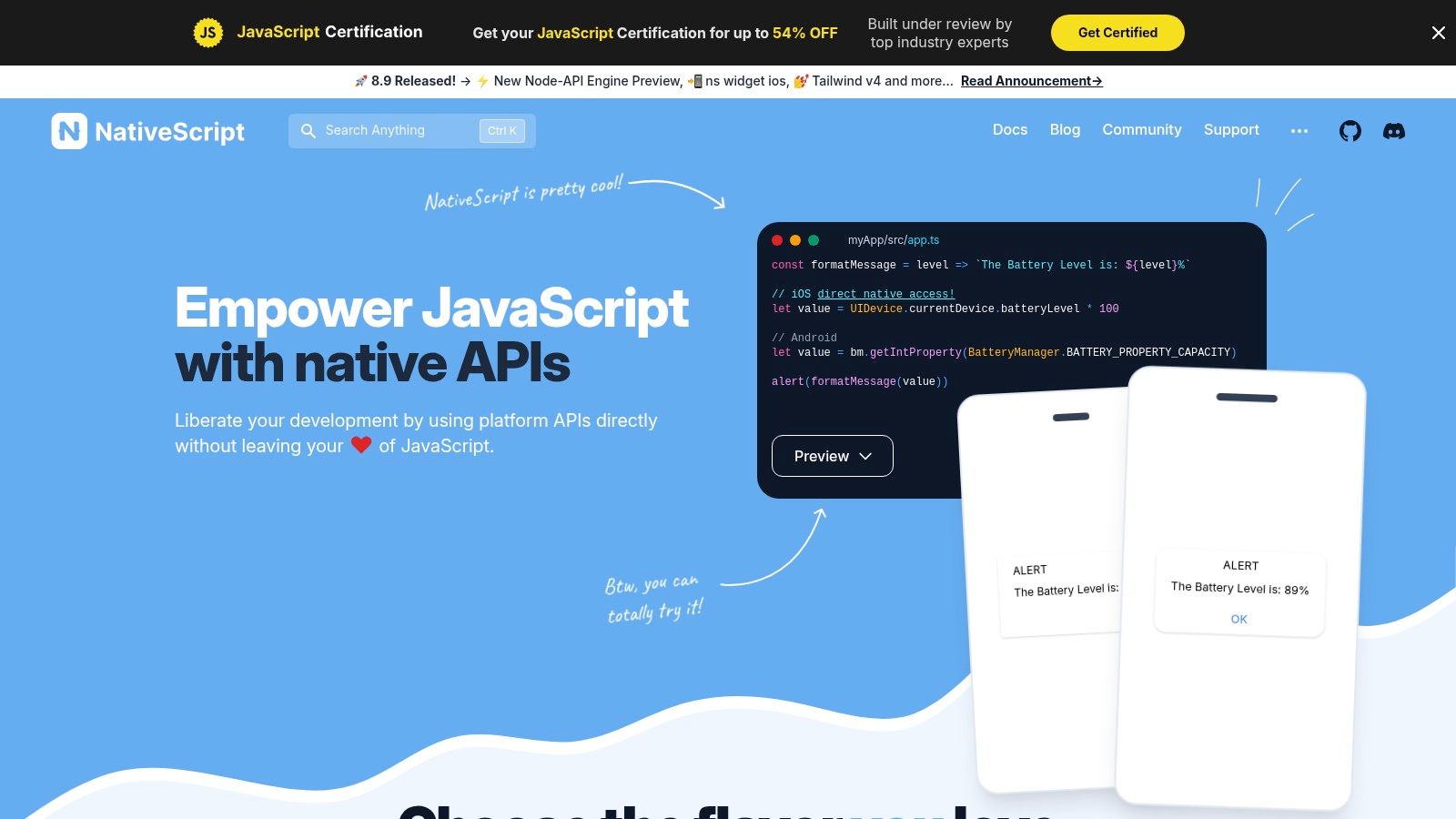
Consider building a mobile application that requires access to the device's camera or GPS. With NativeScript, you can access these functionalities directly from your JavaScript code, leveraging the native APIs without needing to write platform-specific bridge code or search for third-party plugins. This direct access simplifies development and ensures optimal performance. The ability to share code between your web and mobile applications further enhances efficiency, especially beneficial for teams working on both web and mobile platforms simultaneously. This cross-platform development tool allows developers to reuse existing web development skills, lowering the entry barrier for mobile development.
Features:
- Direct access to native APIs from JavaScript: Interact directly with native platform APIs without the need for plugins.
- Native UI components without WebViews: Deliver truly native user interfaces and performance.
- Integration with Angular, Vue.js, or plain JavaScript: Choose your preferred framework or use vanilla JavaScript.
- Shared code between web and mobile applications: Increase code reusability and reduce development time.
- Hot module replacement for faster development: Speed up the development cycle with rapid code reloading.
Pros:
- True native performance and appearance: Offers native performance comparable to natively developed apps.
- No need for platform-specific plugins for core functionality: Simplifies development and maintenance.
- Reuse of skills from web development: Allows web developers to quickly adapt to mobile development.
- Strong integration with popular JS frameworks: Provides flexibility in choosing your preferred framework.
Cons:
- Smaller community compared to React Native or Flutter: Finding solutions to specific issues might be slightly more challenging.
- Steeper learning curve than WebView-based solutions: Requires understanding of native API interactions.
- Less third-party components than some alternatives: May require more custom development for specific UI elements.
- Documentation can be fragmented across framework options: Navigating documentation can be cumbersome depending on the chosen framework.
Website: https://nativescript.org
Pricing: NativeScript is open-source and free to use.
Technical Requirements: Node.js, npm or yarn, and platform-specific SDKs (Xcode for iOS, Android Studio for Android). While a basic understanding of mobile development concepts is helpful, developers with a strong background in web technologies will find the transition smoother.
Implementation/Setup Tips:
- Install the NativeScript CLI globally:
npm install -g nativescript - Create a new project using the CLI:
ns create my-appYou will be prompted to choose a template based on your preferred JavaScript framework (Angular, Vue.js, or plain JavaScript/TypeScript). - Navigate to the project directory:
cd my-app - Run the app on a connected device or emulator:
ns run iosorns run android
NativeScript offers a robust and efficient path to building high-performance cross platform applications with a native user experience. While the learning curve might be steeper than WebView-based solutions, the benefits of true native performance and direct access to native APIs make it a compelling choice for developers seeking optimized performance and a native feel for their cross-platform applications. Consider NativeScript if you're looking for a cross platform development tool that prioritizes native performance and seamless integration with existing web development workflows.
9. Qt
Qt stands out among cross platform development tools for its ability to create high-performance, visually appealing applications deployable on a wide range of platforms – from desktop and mobile to embedded systems and the web. It achieves this with minimal code changes thanks to its comprehensive framework and consistent API. This makes Qt a powerful solution for developers seeking true cross-platform compatibility. Its mature ecosystem, spanning over 25 years, ensures stability and access to a vast array of resources.
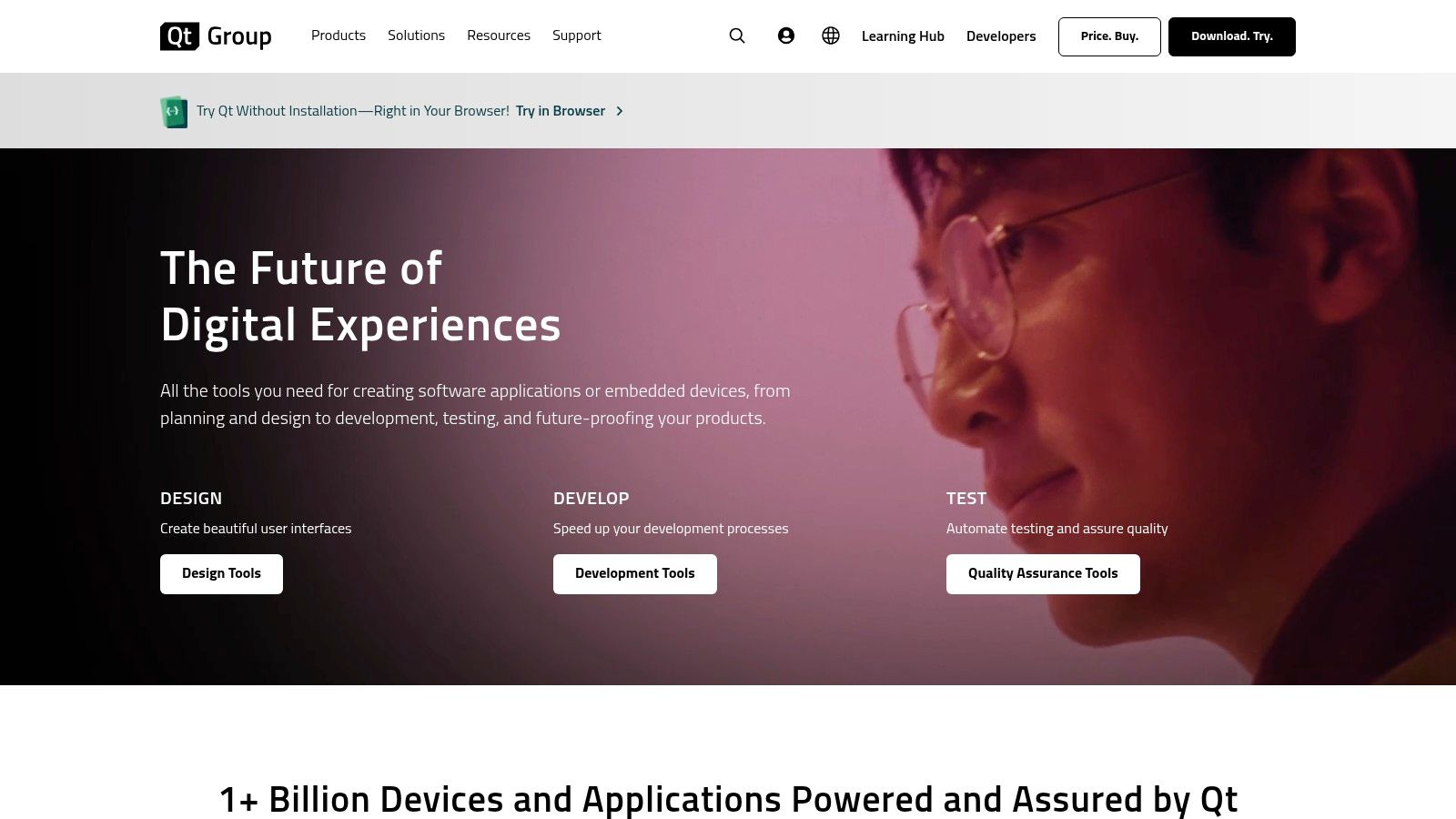
Qt utilizes C++ as its core language, providing excellent performance. However, its support for language bindings like Python, JavaScript, and C# broadens its accessibility to developers with diverse skill sets. This flexibility allows teams to leverage existing expertise while harnessing the power and performance of C++. Qt’s declarative UI design language, QML, further enhances the development process, enabling the creation of fluid and dynamic interfaces. The included Qt Creator IDE provides visual design tools, simplifying the process of crafting user-friendly applications. A rich library of pre-built UI components and functionalities accelerates development and reduces time-to-market. Whether you're building a complex scientific visualization tool, a responsive mobile app, or an embedded system interface, Qt provides the necessary tools and performance.
For developers targeting multiple platforms, Qt offers distinct advantages over platform-specific approaches. While tools like Swift (iOS) or Kotlin (Android) might excel within their respective ecosystems, rewriting substantial portions of the application for each platform becomes a significant overhead. Qt tackles this challenge head-on, allowing developers to write the code once and deploy across multiple operating systems, including Windows, macOS, Linux, iOS, Android, and various embedded systems. This "write once, deploy anywhere" approach significantly reduces development time and costs. Qt also facilitates maintaining a consistent user experience across different platforms, a critical factor for building a strong brand identity.
Pricing and Technical Requirements:
Qt offers both open-source and commercial licensing options. The open-source version is under the LGPL and GPL licenses, while commercial licenses are available for businesses requiring specific features or support levels. The technical requirements vary based on the target platform but generally involve a standard C++ development environment.
Implementation and Setup Tips:
- Download the Qt installer from the official website and choose the appropriate components for your target platforms.
- Familiarize yourself with Qt Creator, the integrated development environment that simplifies the development process.
- Explore the extensive documentation and examples available online to accelerate your learning process.
- Consider using QML for UI design to leverage its declarative approach and create modern, fluid interfaces.
Pros:
- Excellent Performance: C++ foundation ensures high performance.
- Cross-Platform Compatibility: Consistent API across various platforms minimizes code changes.
- Mature and Stable: Over 25 years of development and a large community provide stability and support.
- Comprehensive Tools: Qt Creator and a rich library of UI components streamline development.
Cons:
- Steeper Learning Curve: Compared to some web-based frameworks, Qt may have a higher initial learning curve.
- Commercial Licensing Costs: Commercial licenses can be expensive for some businesses.
- Deployment Size: Qt applications can have a larger deployment size than some alternatives.
- C++ Knowledge: Advanced development often requires deeper C++ knowledge.
Website: https://www.qt.io
Qt deserves its place in this list of cross platform development tools because of its powerful combination of performance, cross-platform reach, and mature tooling. While the C++ core might present a learning curve for some, the benefits of code reusability, consistent user experience, and access to high-performance computing make Qt a compelling choice for serious cross-platform development.
10. Kotlin Multiplatform
Kotlin Multiplatform (KMP) is a powerful cross platform development tool that empowers developers to share code among various platforms, including Android, iOS, web, desktop, and backend systems. This approach differs significantly from traditional cross-platform frameworks. Instead of striving for UI uniformity across platforms, KMP prioritizes sharing business logic, data models, and other non-UI code. This allows developers to leverage platform-specific APIs and UI frameworks for a truly native user experience while still benefiting from the efficiencies of code reuse. For projects seeking optimal performance and native look-and-feel across platforms, KMP is an increasingly attractive option.
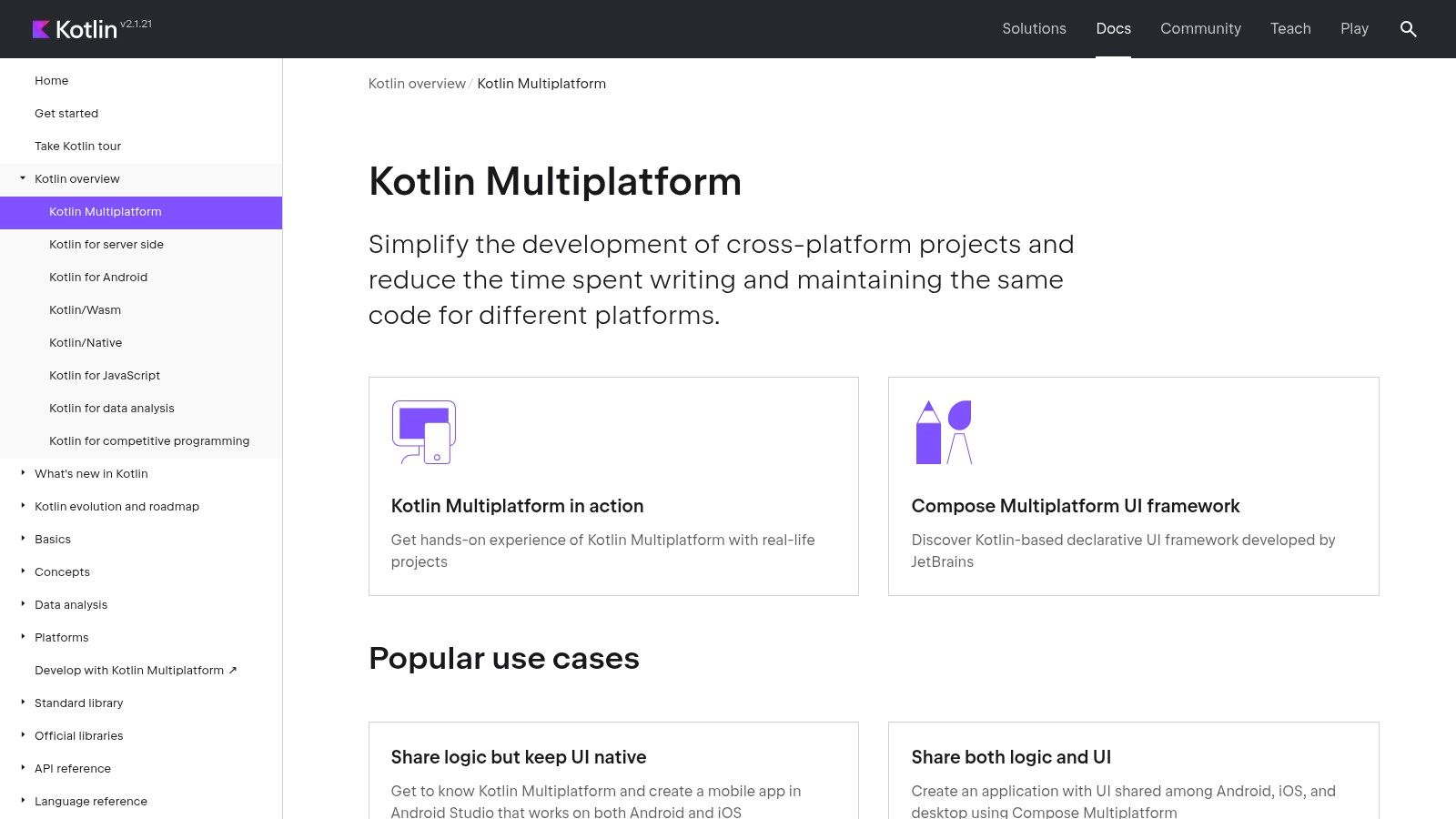
Consider a scenario where you're developing a mobile application for both Android and iOS. With KMP, you can write the core application logic, networking code, and data processing algorithms once in Kotlin and share it across both platforms. This significantly reduces development time and effort while ensuring consistency in functionality. You then create separate, native UI layers using Swift/SwiftUI for iOS and Jetpack Compose/Kotlin for Android, providing users with a familiar and platform-consistent experience. This ability to mix and match shared Kotlin code with native UI code is a key differentiator for KMP among cross platform development tools.
Features:
- Code sharing across multiple platforms: Share code across mobile (Android & iOS), web, desktop, and backend applications.
- Native Performance: Code compiles to native binaries for each platform, ensuring optimal performance.
- Interoperability: Seamlessly integrates with existing codebases in Java, Swift, and JavaScript.
- Gradual Adoption: Introduce KMP incrementally into existing projects, minimizing disruption.
- Native UI Development: Maintain full control over the UI/UX by using platform-specific UI frameworks.
Pros:
- True Native Performance: Delivers native performance on all targeted platforms.
- UI/UX Flexibility: Enables the use of the most suitable UI frameworks for each platform, providing a truly native look and feel.
- Modern Language Features: Leverages Kotlin's modern language features, including strong type safety, null safety, and coroutines.
- Strong Backing: Supported and actively developed by JetBrains and Google.
Cons:
- Relatively New: KMP is a relatively new technology, and best practices are still evolving.
- Platform-Specific UI Implementation: Requires separate UI development for each platform, although this offers maximum flexibility.
- Smaller Ecosystem: Compared to more established frameworks, the KMP ecosystem is still growing.
- Learning Curve: Developers unfamiliar with Kotlin will require some initial learning.
Technical Requirements:
The specific requirements depend on the target platforms. Generally, you'll need the Kotlin Multiplatform plugin for your IDE (IntelliJ IDEA, Android Studio) and the relevant SDKs for each target platform (Android SDK, Xcode for iOS, etc.).
Pricing:
Kotlin Multiplatform is open-source and free to use.
Website:
https://kotlinlang.org/docs/multiplatform.html
KMP deserves a prominent place in this list of cross platform development tools due to its unique approach. By focusing on code sharing rather than UI abstraction, KMP offers a compelling solution for developers seeking performance and native UI/UX without sacrificing the benefits of code reuse. This makes it a valuable tool for a broad audience of software developers, from mobile app developers to backend engineers and everyone in between, seeking efficiency and high performance in cross-platform development.
Top 10 Cross-Platform Development Tools Comparison
| Framework | Core Features ✨ | Performance & Stability ★★★★☆ | Target Audience 👥 | Unique Selling Points 🏆 | Pricing & Value 💰 |
|---|---|---|---|---|---|
| Flutter | Single codebase, Hot Reload, Native ARM | Near-native speed, strong debugging | Mobile & desktop developers | Rich customizable widgets, Google backing | Free, open-source |
| React Native | JS + native components, Live Reload | Good, slight lag on complex graphics | JS/web developers | Large ecosystem, direct native API access | Free, open-source |
| Xamarin | C#/.NET, native UI & API access | Native performance, MS integration | .NET/C# developers | Visual Studio integration, shared UI code | Free/community, paid tiers |
| Ionic | Web tech (HTML/CSS/JS), framework agnostic | Lower for complex apps, WebView-based | Web developers, cross-platform UI focus | Pre-designed adaptable UI components | Free, open-source |
| Electron | Web tech desktop apps, Node.js APIs | Moderate, high memory use | Web developers targeting desktop | Cross-platform desktop apps, rich plugins | Free, open-source |
| Unity | Visual editor, multi-platform, physics | High for games, resource intensive | Game devs & interactive content creators | Asset store, broad platform support | Free tier + paid subscriptions |
| PhoneGap/Cordova | Web tech, native plugin access | Moderate, WebView UI limitations | Web devs prototyping apps | Extensive plugin ecosystem | Free, open-source |
| NativeScript | Direct native UI, JS/TS/Angular/Vue | True native performance | JS devs needing native UI | No WebViews, direct native API access | Free, open-source |
| Qt | C++ framework, IDE, QML UI design | Excellent C++ performance | C++ devs, embedded & desktop apps | Mature, stable, comprehensive tools | Commercial licenses optional |
| Kotlin Multiplatform | Shared codebase, platform-native UI | True native performance | Kotlin developers & multiplatform apps | Interop with Java/Swift, gradual adoption | Free, open-source |
Choosing the Right Tool for Your Cross-Platform Journey
Selecting the ideal cross platform development tools hinges on a variety of factors, from project requirements and team expertise to performance needs and budget constraints. We've explored ten popular options, each with its own strengths and weaknesses: Flutter, React Native, Xamarin, Ionic, Electron, Unity, PhoneGap/Apache Cordova, NativeScript, Qt, and Kotlin Multiplatform. Remember, there's no one-size-fits-all solution; the "best" tool depends entirely on your specific context.
Some key takeaways to consider when making your decision: Do you prioritize native performance or rapid development? Is your team proficient in JavaScript, C#, or Dart? What's your target audience and platform reach? Considering these questions will guide you toward the most suitable cross platform development tools for your project. When embarking on cross-platform development, maintaining clear and comprehensive documentation is paramount. Understanding how to effectively document your codebase, regardless of the chosen tool, ensures maintainability, facilitates collaboration, and streamlines onboarding for new team members. For a deeper dive into documentation best practices, refer to this comprehensive guide: best practices for documenting code.
By carefully evaluating your project's needs and considering the insights provided in this listicle, you can choose the best tool to create high-quality cross-platform applications that achieve your development goals.
Streamlining your codebase structure is key to efficient cross-platform development, regardless of your chosen framework. Visualize and optimize your project's architecture with TreeSnap, a powerful tool that helps you understand dependencies, identify potential bottlenecks, and maintain a clean codebase as your project scales.